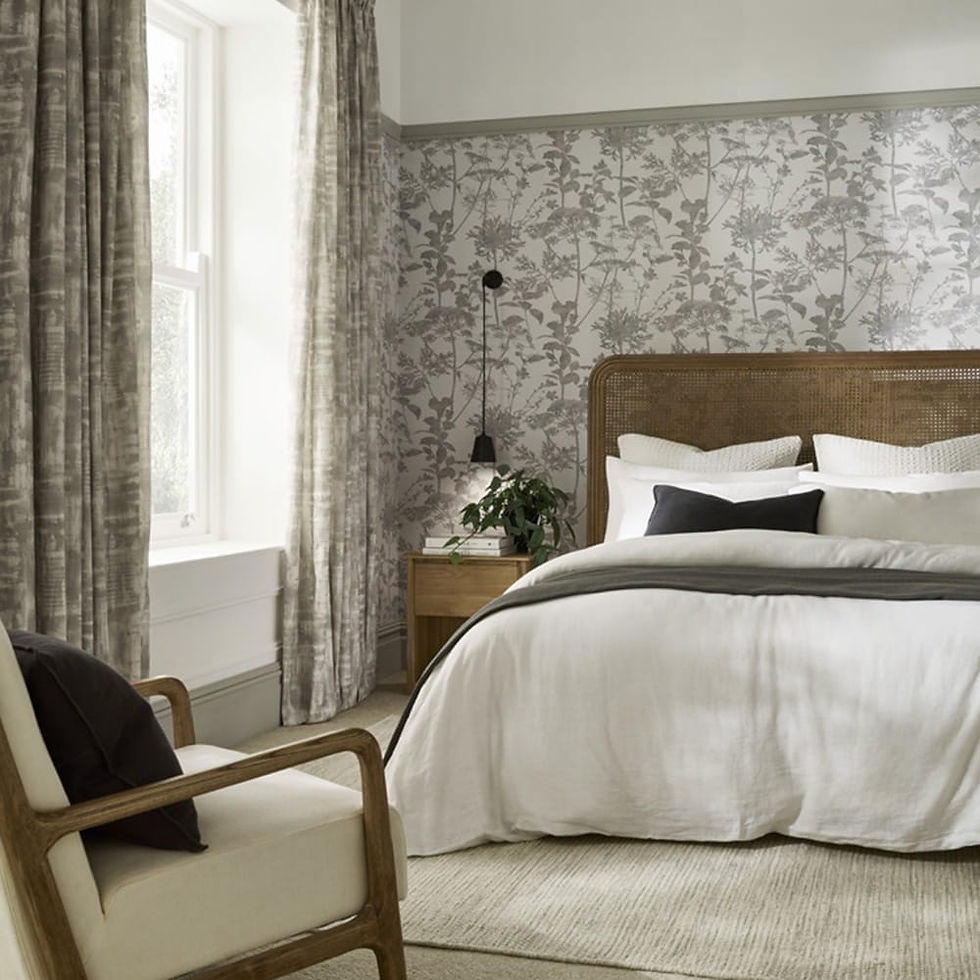Textured Wallpaper: Fresh Wallpapering Ideas for Every Room
- Studio Jeandré

- Jul 30, 2025
- 4 min read
Textured wallpaper has become one of the most sought-after design elements for homeowners and interior designers alike. Unlike flat paint or basic printed wallpaper, textured wallpaper introduces depth, warmth, and character to any space. Whether you're searching for wallpapering ideas for the living room, a cosy textured wallpaper in the bedroom, or a sleek modern wallpaper with subtle dimension, this guide covers everything you need to know.
We’ll explore different styles—from grasscloth wallpaper to Japandi-style wallpaper—and provide practical tips on choosing, installing, and maintaining textured walls. Let’s dive in!
Why Choose Textured Wallpaper?
Textured wallpaper offers unique advantages that flat finishes simply can’t match. Here’s why it’s worth considering:
1. Hides Imperfections
Walls with minor dents, cracks, or uneven surfaces can be tricky to disguise with paint alone. Textured wallpaper helps mask these flaws, making it a great choice for older homes or rooms with less-than-perfect drywall.
2. Adds Visual Depth Without Overwhelming
If you love neutral palettes but want to avoid a flat, boring look, texture introduces subtle dimension. A grasscloth wallpaper in beige or a linen-effect design keeps things soft yet interesting.
3. Enhances Lighting & Atmosphere
Textured walls interact beautifully with light, creating soft shadows that change throughout the day. This effect can make a room feel cosier in the evening and more dynamic during daylight.
4. Durable & Long-Lasting
Many textured wallpapers, especially vinyl or fibre-based options, are more resistant to scuffs and wear than flat paint. This makes them ideal for high-traffic areas like hallways and living rooms.
5. Works with Any Design Style
From rustic to ultra-modern, textured wallpaper adapts effortlessly. Japandi-style wallpaper blends Scandinavian minimalism with organic warmth, while embossed geometric patterns suit contemporary spaces.
Best Textured Wallpaper Ideas by Room
1. Wallpapering Ideas for Living Room
The living room is where texture can make the biggest impact. Consider these approaches:
a) Grasscloth Wallpaper for Organic Warmth
Natural woven fibres like bamboo or jute add earthy elegance. Works well behind sofas or as a feature wall near the fireplace.
b) Geometric & 3D Textures for Modern Spaces
Raised patterns, like hexagonal or wave designs, create a bold focal point without loud colours.
c) Faux Concrete or Plaster Finishes
For an industrial-luxe vibe, textured wallpaper mimicking concrete or Venetian plaster adds depth while keeping a neutral palette.
2. Textured Wallpaper in Bedroom
Bedrooms benefit from softer, cosier textures. Try:
a) Fabric-Like Finishes (Linen, Silk Effect)
These add a luxurious, hotel-like feel. Pair with layered bedding for extra comfort.
b) Subtle Metallic Textures
A hint of shimmer (like pearlescent or brushed metal designs) elevates the space without being too flashy.
c) Nature-Inspired Textures (Wood Grain, Stone)
Great for creating a serene, spa-like retreat.
3. Kitchen & Dining Area Accents
Textured wallpaper isn’t just for living spaces—it can work in kitchens too (away from direct splashes). Try:
Textured peel-and-stick backsplashes (easy to clean)
Washable textured wallpaper in dining nooks for added warmth
4. Hallways & Entryways
Since these areas take a lot of wear, opt for durable textures like:
Embossed vinyl wallpaper (scrub-resistant)
Faux brick or stone for a striking first impression
Popular Textured Wallpaper Styles
1. Grasscloth Wallpaper
Pros: Natural, breathable, adds organic texture
Cons: Not ideal for high-moisture areas
Best for: Living rooms, home offices, dining spaces
2. Japandi-Style Wallpaper
Pros: Blends minimalism with warmth, neutral tones
Cons: Limited bold patterns
Best for: Bedrooms, reading nooks, meditation spaces
3. Embossed & 3D Wallpaper
Pros: Hides flaws, modern aesthetic
Cons: Harder to remove
Best for: Feature walls, modern living rooms
4. Faux Material Wallpaper (Brick, Wood, Marble)
Pros: Realistic look without the cost
Cons: Can feel flat compared to real materials
Best for: Accent walls, rental-friendly upgrades
How to Choose the Right Textured Wallpaper
1. Consider the Room’s Lighting
Low light? Avoid overly rough textures—they can cast harsh shadows.
Bright rooms? Matte textures work well to reduce glare.
2. Match Texture to Your Style
Modern: Geometric, concrete-effect
Rustic: Grasscloth, linen-look
Luxury: Silk-effect, metallic finishes
3. Think About Maintenance
High-traffic areas need scrubbable vinyl or washable textures.
Delicate materials (like grasscloth) suit low-contact zones.
Installation Tips for Textured Wallpaper
Prep the Walls – Smooth out major imperfections, clean, and prime.
Choose the Right Adhesive – Heavy textures may need stronger paste.
Take Your Time – Textured wallpaper can be trickier to align; work in small sections.
Consider Professional Help – For intricate patterns or high walls, hiring an installer ensures a seamless look.
Textured wallpaper is a simple yet powerful way to elevate your home’s design. Whether you opt for grasscloth wallpaper in the dining room, a Japandi-style wallpaper in the bedroom, or a bold 3D pattern in the living room, texture adds depth and personality.
Ready to experiment? Start with a small accent wall to see how the texture plays with your lighting and decor. And if you’re still unsure, many brands offer peel-and-stick wallpaper samples to test before committing.

























































Comments